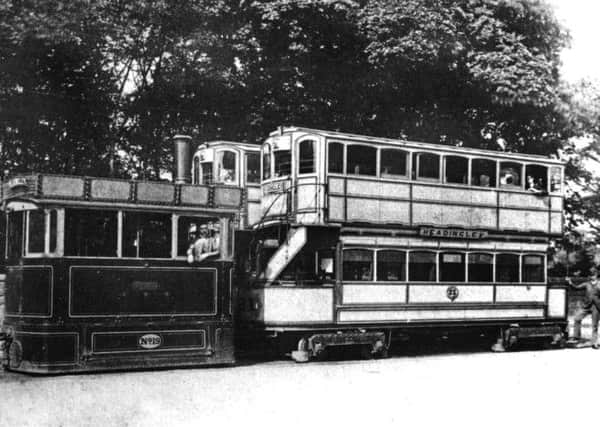On the buses... 1880s style


Irate letters were received by the Yorkshire Post and in one of them, dated January 18 1883, W.H. Maude wrote: ‘Last evening I rode up to Headingley on the top of the tramcar drawn by the engine and whatever our authorities are doing to allow such a nuisance as this diabolical machine to travel another time up that road I do not know.
“Up Cookridge Street and Woodhouse Lane, the engine did not send an odd spark or two out of the chimney, but one continuous stream of sparks 10 or 12 feet high, and covering passengers on the top with pieces of cinder insomuch that some put up their umbrellas to protect themselves. How horses will be got to face such an infernal machine goodness only knows.”
Advertisement
Hide AdAdvertisement
Hide AdSteam trams were also to be found in a number of other Yorkshire towns and cities, including Bradford, Hull, York and Dewsbury.
This form of transport, known as mechanical traction, was first pioneered abroad. In the US, steam trams were used on the New York and Harlem line from 1831 and in Philadelphia between 1859 and 1861. But they found little success. It was not until 1873 that the first steam tram ran in London, although this, too, was unsuccessful. A steam tram route in the West midlands operated the first successful carriage of fare-paying passengers on January 8 1876.
Two renowned steam tram builders, Thos Green & Son Ltd and Kitson & Co, were based in Leeds. Thomas Green started as a wireworker with a modest shop in Lowerhead Row in 1835. Then he moved on to manufacturing implements for the wider horticultural trade and by the 1850s he was making hand rollers and lawnmowers. Later, the production of small combined boiler/engine units began and it was not long before Green’s began to produce in 1882 the first of over 200 steam tram locomotives. Kitson & Co of the Airedale Foundry had a humble beginning in 1837 but started building tram engines from 1876 to a design by W.R. Rowan of Copenhagen. Two years later they went on to produce their own design of a vertical boilered tramway engine and in total around 300 steam tram engines were built.
The firm produced an experimental steam tram engine in 1877 and it ran on a trial basis from October that year for two weeks on the Leeds tramways system. At this time the system was served by horse-drawn trams and operated by the Leeds Tramways company.
Advertisement
Hide AdAdvertisement
Hide AdThe Yorkshire Post of October 25 1877 carried a brief description of the vehicle on the first run between the Hunslet depot and Kirkstall: “It is about half the size of an ordinary [horse car], and in the centre of it is a vertical boiler, with funnel passing through the roof. The wheels and brakes are shielded by sheet iron to within about 4” of the ground. The upper half of the engine car except for the top is glass so that the driver can see in any direction.”
During December 1877 Kitson’s engines made further runs although objections were raised over the emission of steam and smut from the funnel and some horses were disturbed.
The subsequent introduction of the Use of Mechanical Power on Tramways Act of 1879 heralded the beginning of steam tramways for urban areas. Yet strict rules had to be followed: locomotives could not exceed 10 mph; all working parts had to be enclosed to within four inches of the roadway; and no visible smoke or steam was to be emitted.
Once this legislation became law, the Meanwood and Wortley tramways were laid with strengthened rails anticipating the introduction of steam trams. Shortly afterwards, authorisation was given by the Board of Trade to run a steam tram on the Wortley line for three months from June 14 1880 using a Kitson engine. It weighed just under six tons. Three days later it was employed for the first time in passenger service.
Advertisement
Hide AdAdvertisement
Hide AdFollowing further trials permission was sought to run steam trams on all Leeds routes and this was granted after the passing of the Leeds Tramways Act 1881.
By August 1881 the Wortley route was entirely operated by steam trams and it was announced that they could be operated at ten shillings less than a tram car drawn by three horses.
Thus, during the last quarter of the 19th century there was a mixture of horse drawn trams, horse-drawn buses and steam trams. But public transport was largely too expensive for the working classes and only connected the city to the more affluent outlying areas.
Forty five steam tramways opened in the UK during the 1880s, but the steam tram era did not last long.
Not one system was opened in the 1890s, operators instead switching to electric traction. The last steam tram ran in Leeds on June 1 1902.